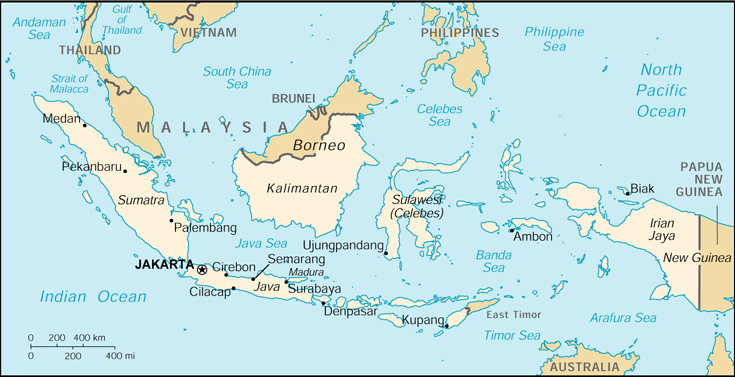German emigration to the Dutch Indies |
Updated: 17.01.2010 |
General InformationThe Dutch Indies or Dutch East-Indies existed until December 27th, 1949 in its greatest dimension within the boundaries of present day Indonesia. Geography: The colony consisted of a group of islands which extended 5,120 Km in a east-west direction and 1,760 Km in a north-south direction. It is situated between 6° 08' northern and 11° 15' southern latitude as well as 94° 15' and 141° 05' eastern longitude. It is an archipelago which consisted of more than 13,677 islands of which 6.044 were inhabited. It subdivides into five larger islands:
the two groups of islands:
as well as sixty further groups of islands. The climate is tropical, hot and moist. On Sumatra, West-Java, Kalimantan, Sulawesi, the Maluku islands and Irian Jaya the climate is always moist and tropical. The annual amount of precipitation is 3,000 to 4,000 mm, in the mountains partially over 6,000 mm, on Middle- and East-Java, the small Suda islands as well as in the area up to the Aru islands there is tropical-monsunal climate. The amounts of precipitation there is 2.000 to 3.000 mm. The landscape mainly consists of a flat coast line; the mountains are in the interior of the larger islands. The country has rich mineral resources: Minerals, oil and
gas on Sumatra, Kalimantan, and Irian Jaya, nickel on Sulawesi,
tin on Bangka and Belitung, tropic precious woods in the tropical
rainforests, bauxite on Bitan and Kalimantan, copper on Irian
Jaya and Timor, mineral coal on Sumatra, gold and silver. |
on this page: Genealogical and Historical Records
|
HistoryThere were several Islamic Sultanates at the end of the 15th century on the area of present Indonesia. With the discovery of the sea way to India in 1498 the Europeans rushed into the southeast Asian region in order to overtake the spice market operated by Orientals. The Dutch first came to Indonesia in 1596 when the spice market already was controlled by the Portuguese. In 1602 the Netherlands parliament created a charter company for the commercial exploitation as a monopoly of the areas east of the Cape of Good Hope. This became the Vereenigde Oost-Indische Compagnie (VOC) or the Dutch East India Company. The charter, which had granted the VOC the rights of a sovereign, had the company undertake its first commercial expedition in the same year of its founding. This was to the "spice islands" or the Maluku islands. The core business of the VOC was the export of peppers and spices. 1619 eroberte der niederländische Handelsgouverneur In 1619 the Dutch trade master, Jan Pieterszoon Coen, conquered Jayakarta (the present Jakarta) and founded a Dutch colony which he called Batavia. On December 31, 1799 the Dutch government removed the Vereenigde Oost-Indische Compagnie (VOC). The company had gone bankrupt through mismanagement and corruption. The government took charge of all regions, which had been under the influence and control of the VOC, as colonies. Registry offices (De burgerlijke stand) were established in 1828. Beginning in 1830 the Dutch-Indies were developed into an efficient colony under governor-general Bosch. However the Dutch had to continually defend their claim to power against various locals chiefs as well as the English and Portuguese in several wars. While doing so, the colonial area was constantly extended. In the contract of Sumatra in 1871, the Dutch gave up their possessions on the Gold Coast in Africa and instead received domination from Britain over Sumatra. With the Japanese attack on the American Pacific fleet in Pearl Harbour (Hawaii) on the 7th of December 1941 the 2nd World War also began in the Pacific. On January 10th, 1942 the Japanese attacked Kalimantan, Sulawesi and Ambon. In the battle in the Java sea dated February 27th until March 1st, 1942, the Japanese destroyed the allied fleet and the invasion on Java began. On March 8th, 1942, the Dutch had to capitulate on Java. With surrender the remained soldiers of the Dutch colonial army K.N. I.L. (Koninklijk Nederlands-Indische Leger) went into captivity. The Japanese army immediately erected Prisoner of War and internment camps in schools, prisons, railroad sheds, hut camps and other assembly places for the allied Prisoners of War and citizens of the countries with which they were at war. Men were separated by their families. Boys from 10 years were separated from their mothers and brought into the mens camp. The situation in the camps was catastrophic, food and medicine did not exist and the result was an outbreak of various epidemics. Treatment through Japanese was brutal and murderous. Forced labor also resulted many deaths. On August 15th, 1945 the Japanese capitulated in Indonesia, however, still controlled wide parts of the country. On September 2nd, 1945, the Japanese signed the unconditional surrender. For many Prisoners of War this meant survival, because there was an order of the Japanese high command to all troops to kill all allied Prisoners of War, in case the first Ally puts his foot onto the Japanese main islands. On August 17th, 1945, Sukarno and Hatta exclaimed the independence of free Republic of Indonesia. Between Indonesian adolescents and the Dutch dismissed from the internment camps, violence spread. Bloody fights between organized Indonesian independence fighters and Dutch, English and Australian troops took place. Because of the quarrels in the Dutch Indies many former KNIL soldiers were called back again to Indonesia, after they had survived the Japanese Prisoner of War camps, and had already gone to Netherlands partly, in order to participate in the fights. In April 1949, the Dutch began to bend to international pressure and agreed, to provide independence to Indonesia. On December 27th, 1949, the Netherlanders handed over the sovereignty officially to Republic of Indonesia. The Dutch Indies stopped to exist. Many Dutch families left the colony and went back home to the Netherlands. German emigrants are already provable in the colony with the first colonizers. Many of them went back to the Netherlands after the end of the colonial time. Sources: |
 |
Genealogical Societies
|
|
Genealogical and Historical RecordsChurch RecordsCivil Registration RecordsOther Records
|
|
Gazetteers and MapsGazetteersAtlases and Maps
|
|
Bibliography and LiteratureHistorical Literature (Dutch)
Historical Literature (German)Genealogical Literature |
 |
Archives and LibrariesArchives
Libraries
|
|
Miscellaneous ResourcesNewspapers
Phone books Regions of Origin |
|
|